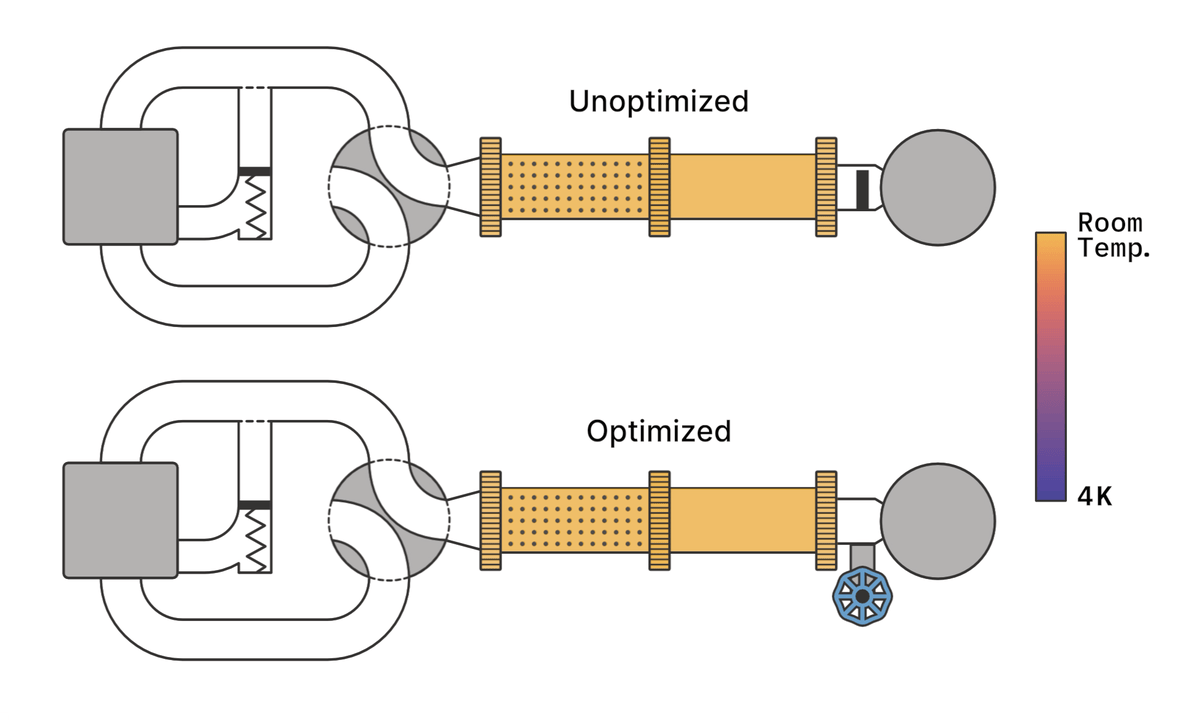NIST Scientists Modify Common Lab Refrigerator to Cool Faster with Less Energy
 In a groundbreaking development, scientists at the National Institute of Standards and Technology (NIST) have engineered a significant enhancement to the efficiency of cooling materials to temperatures near absolute zero. Through modifications to a commonly used laboratory refrigerator, they have achieved remarkable reductions in both cooldown time and energy consumption. This innovation holds profound implications for various fields reliant on ultracold temperatures, from quantum computing to astronomy and superconductors.
In a groundbreaking development, scientists at the National Institute of Standards and Technology (NIST) have engineered a significant enhancement to the efficiency of cooling materials to temperatures near absolute zero. Through modifications to a commonly used laboratory refrigerator, they have achieved remarkable reductions in both cooldown time and energy consumption. This innovation holds profound implications for various fields reliant on ultracold temperatures, from quantum computing to astronomy and superconductors.
The prototype device, now in the process of commercialization in collaboration with an industrial partner, promises substantial savings in power consumption, estimated at 27 million watts annually. Additionally, it is projected to save $30 million in global electricity costs and conserve enough cooling water to fill 5,000 Olympic swimming pools. (These numbers are on an annual basis, and the dollar savings come from the electricity savings.)
For decades, the pulse tube refrigerator (PTR) has been instrumental in achieving the ultracold temperatures necessary for numerous applications. These refrigerators operate by cyclically compressing and expanding high-pressure helium gas, akin to the principles underlying household refrigeration but on a far more extreme scale. However, despite their reliability, PTRs have been notorious for their voracious appetite for power, consuming more electricity than any other component in ultralow temperature experiments.
Upon closer examination, NIST researchers identified a critical inefficiency in PTRs: their design prioritized cooling performance at their final operating temperature of 4 K, at the cost of energy efficiency during cooldown. At higher temperatures, particularly during the initial cooling phase from room temperature, these refrigerators exhibited significant energy wastage.
Through a series of innovative adjustments to the refrigerator’s mechanical connections, led by researcher Ryan Snodgrass and his colleagues Joel Ullom, Vincent Kotsubo and Scott Backhaus, NIST addressed this inefficiency. By optimizing the flow of helium gas from the compressor to the refrigerator through a series of dynamically controlled valves, they ensured that none of the gas was wasted, thereby drastically improving efficiency.
Their approach involved continuously adjusting these valves, allowing for a larger opening at room temperature and gradually closing them as cooling progressed. This simple yet ingenious method resulted in a reduction of cooldown time to between 60 and 30 percent of the previous duration. Previously, scientists had to wait a day or more for new quantum circuits to reach the required temperatures for testing. With this enhancement, the time barrier to reaching cryogenic temperatures is significantly diminished, potentially accelerating progress across various fields, particularly quantum computing.
Furthermore, this innovation opens avenues for downsizing refrigeration equipment, as smaller PTRs could replace larger, less efficient models, requiring less supporting infrastructure. As the demand for ultracold temperatures, driven by advancements in quantum computing and related technologies, continues to surge, the implications of this development become increasingly significant.
Ryan Snodgrass explains the modification’s efficiency enhancement: “For status quo pulse tube refrigerators, a significant portion of the helium flow generated by the compressor is not used by the refrigerator during the cooldown process. This is inefficient because the compressor consumes an enormous amount of electricity to produce that flow. In the new, optimized configuration, all of the flow generated by the compressor is utilized by the refrigerator.”
Regarding potential implications for various industries and scientific research fields, Snodgrass adds, “The implications of faster and more efficient cooldowns is increased accessibility of 4 K and below temperatures. This is achieved in two ways. First, experimentalists can significantly increase their work throughput. For example, an experiment that previously took a full day to cool down may now be cooled in less than 8 hours, so experimentalists may be able to start low temperature characterization before leaving work for the day. The second impact to accessibility is through miniaturization of cryostats. Cryocoolers that were previously oversized to achieve acceptable cooldown times can be replaced with much smaller ones that consume less electricity and cooling water and occupy less space. It is important for the cryocooler industry to increase the efficiency of these systems since they are continuously becoming more ubiquitous.”
Published in Nature Communications, the research outlines a dynamic acoustic optimization method for PTRs, providing a blueprint for rapid cooldown capabilities. The collaboration between NIST and the University of Colorado Boulder underscores the interdisciplinary nature of this pioneering work.[1]
Beyond its immediate applications, this breakthrough represents a significant step towards sustainability in scientific research, offering substantial reductions in energy consumption and associated costs. By expediting the cooling process, it accelerates scientific discovery and innovation, paving the way for transformative advancements in fields reliant on ultracold temperatures. www.nist.gov
Reference:
[1] Snodgrass, R., Kotsubo, V., Backhaus, S., & Ullom, J. (2024). Dynamic acoustic optimization of pulse tube refrigerators for rapid cooldown. Nature Communications, 15, Article number: 3386. https://doi.org/10.1038/s41467-024-47561-5


